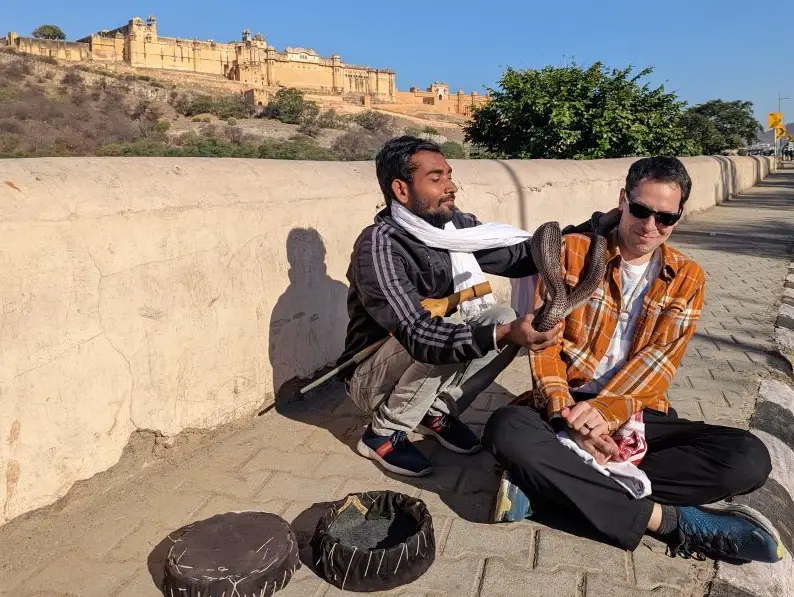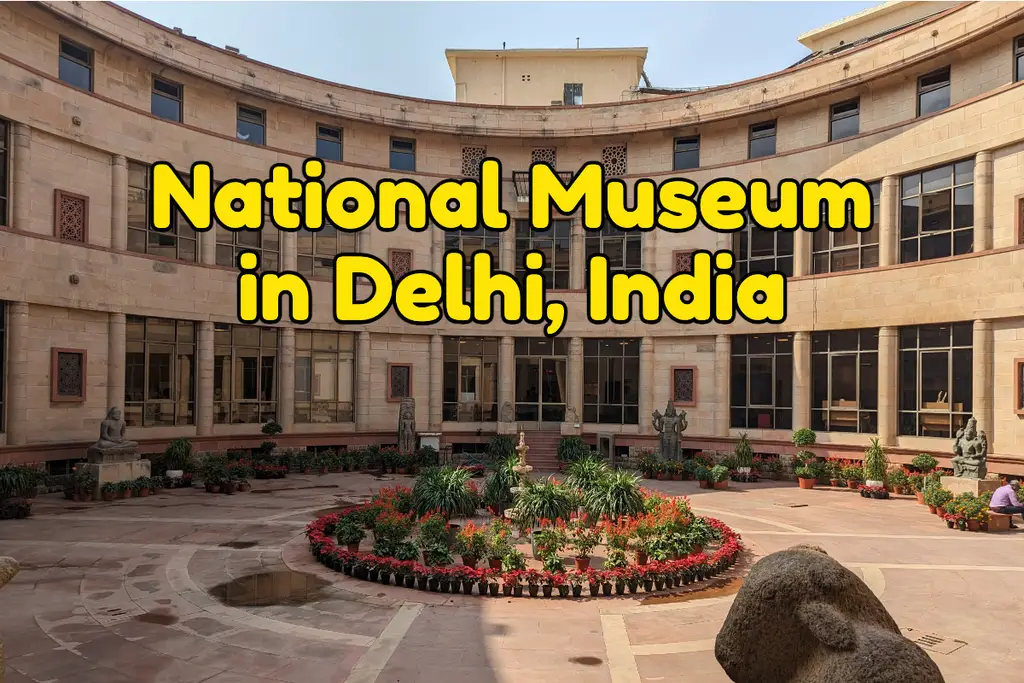
Before I went to Jaipur, I was exposed to “snake charmers” through cartoons like Aladdin, the Jungle Book, and Tom and Jerry. I thought about them as something that I would likely never see, something that was a relic of a time long ago. Still, when I got to India I was curious, would I see a real snake charmer there? Do they really exist?
The answer is YES they exist and I got to sit right next to one and get up close and personal with his Cobra!
This and many more experiences in my trip to India
The Scene of a Snake Charmer
We were on our way to the entrance to the Amber Fort, and along the way, our guide stopped the car and escorted us to the side of the road. On nearly every occasion when I’ve been walking with a guide they have explicitly told me to not engage with people asking for photos, money, or trying to sell me anything. I expected that this would be the same here and was happy that there were actually very few people on this small sidewalk.
But no, my guide walked me up to a man who quickly set up to show off his skills in snake charming, and before I knew it he was sitting 3 feet in front of me with an interesting instrument and a small round package in front of him. As he started playing the instrument, rising quickly from the package was a cobra, staring at his hands as he swayed the instrument left and right playing this odd tune.
As I watched I was curious, how dangerous was this? My guide told me that in order to promote safety the snake had its poisonous fangs removed. At this point, I had been in India for about 10 days and I already knew that what people said was not always the truth and unfortunately more often I found that they were just lying to me. So I wanted to believe him, but I was skeptical.
Petting the Cobra of the Snake Charmer
After a very short time of watching what appeared to be a hypnotized Cobra, my wife and I were invited to get within striking distance! Naturally, my wife gave me a gentle push forward and said that she wasn’t going to do it. On the other hand, I knew that I wanted to do it but I considered what the true danger could be. I do travel with a venomous snake bite kit due to my preference for remote treks, but I was in a city and didn’t have it with me. In addition, a snake bite could still do damage without the venom and how much did I trust this person who I was going to sit next to?
Sometimes you just have to go with the flow. So I sat next to the snake charmer as he continued to hypnotize the snake. Then he introduced me to his cobra and motioned for me to touch it. The cobra was facing him and he was holding up its container to get the snake closer to me. I touched the Cobra’s head and back a bit, it felt like a very solid scaley leather with a rubbery feel. At first, I was guarded, what if it decided to strike? Then I relaxed a bit as I gained more trust and felt a bit more comfortable with the situation, pictures below.


Afterward, the snake charmer wanted to give me a real experience by putting the Cobra directly on me! I’m typically adventurous in this way, but once again my level of trust in the person I met 5 minutes ago and his Cobra snake was less than where I would want it for this type of situation. So here I am on the streets of Jaipur with a stranger who doesn’t speak my language and a cobra that may or may not be poisonous hanging out on my shoulder with its big India Jones-style face staring me down. My face says it all, I am not comfortable but inside I simply wished to have more trust in this person and his snake so that I could really dig into the experience.

The Pungi – the Snake Charmer Instrument
The instrument used by the snake charmer is called the “Pungi”. The melodies played on the pungi are believed to attract snakes, evoking their interest. The slow, repetitive tunes and rhythms as well as the musicians swaying motions are thought to create the trance-like hypnosis state in the snakes. The instrument itself is a symbol, a symbol that has been represented in Indian art for generations and represents an iconic representation of the connection between humans and snakes.
The sound that comes out of it was odd to me. The melodies coming from the Pungi seemed to have a background buzz. Personally I was curious if it was the sounds emitting from the instrument that was causing the Cobra to be calm or the swaying motions of the musician or whether both was required for the effect.
Conflicts of Snake Charming
After having that experience I felt the need to research the ethics behind this practice. I learned that there was a significant cultural history to snake charmers, they performed during festivals, religious ceremonies, and celebrations, adding an element of mysticism and folklore to those occasions.
However in 1972 an act was introduced, the Wildlife Protection Act of 1972. The Wildlife Protection Act made it illegal to capture, possess, or trade certain species of snakes, including cobras. The goal was to provide legal protection to prevent the exploitation of snakes, and to promote their conservation and well-being. This had clear impacts on snake charmers.
So unfortunately, it is possible that I may inadvertently have supported this activity, and I felt the need to dig deeper.
Why is Snake Charming still happening in India
First and foremost is economic necessity. Being in India I was acutely aware of the many poor people in every town and city that I visited. Snake charming provides still people with income. Moreover, your average India citizen may not even be aware of the 1972 wildlife act that protects snakes and other animals. In the most likely case, snake charming has been passed down from generation to generation and has played a significant role in the nations and locals cultural heritage.
I also cannot ignore the fact that there is still tourist demands for snake charmers, a role that I and many other tourists have played unknowingly.





